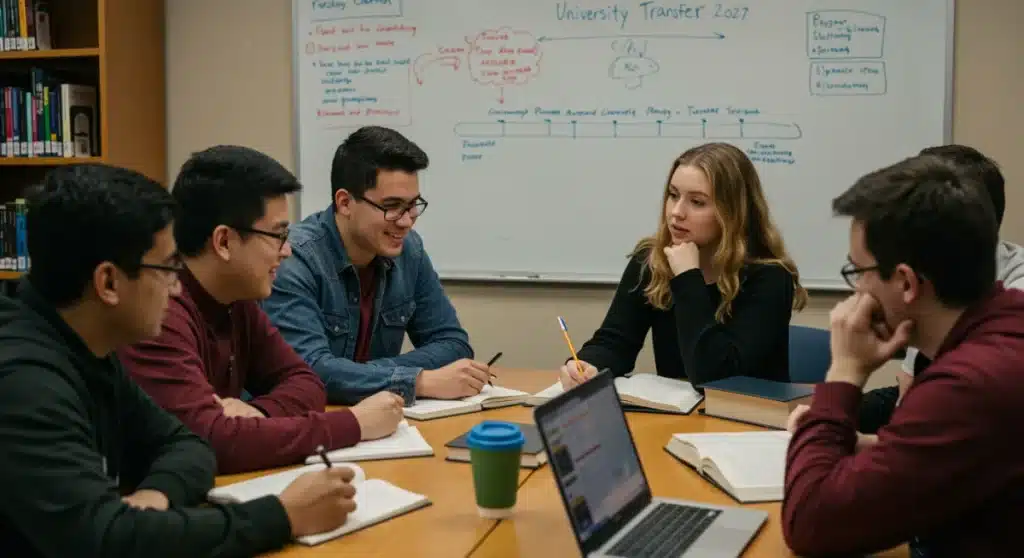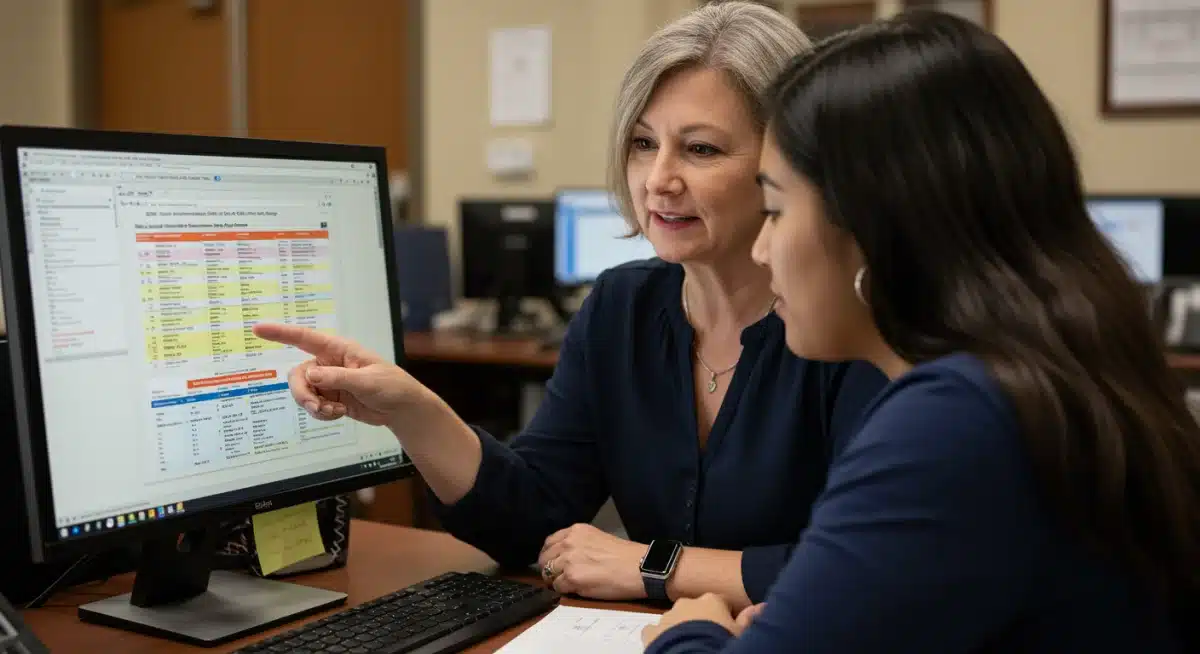Community College Pathways: 2-Year US University Transfer

Community college pathways provide an accessible and affordable route for students to complete their first two years of higher education before transferring to a four-year US university, effectively preparing them for a bachelor’s degree by 2027.
Embarking on higher education can feel daunting, but for many, community college pathways offer an intelligent and accessible starting point. This strategic approach allows students to complete their foundational studies affordably before seamlessly transitioning to a four-year university. If your goal is to earn a bachelor’s degree from a US university by 2027, understanding these pathways is crucial for a successful and cost-effective academic journey.
Understanding community college pathways
Community college pathways serve as structured educational routes designed to facilitate the transfer of credits and students from two-year institutions to four-year universities. These pathways are not merely about saving money; they are about providing a supportive environment, smaller class sizes, and often more flexible schedules that can be ideal for students adjusting to college life or balancing other responsibilities.
Many community colleges have established articulation agreements or transfer agreements with specific universities. These agreements outline which courses will transfer and how they will apply towards a bachelor’s degree. This pre-planned curriculum ensures that students are taking the right courses from day one, minimizing wasted time and money.
The benefits of starting at a community college
- Affordability: Community colleges generally have significantly lower tuition rates than four-year universities, leading to substantial savings on the first two years of college.
- Accessibility: Admission requirements are often less stringent, making higher education more accessible to a broader range of students.
- Smaller class sizes: This often translates to more personalized attention from instructors and a more supportive learning environment.
- Flexibility: Many community colleges offer a variety of course formats, including online, evening, and weekend classes, catering to diverse student needs.
In essence, community college pathways are a strategic bridge, allowing students to build a strong academic foundation and prepare for the rigors of a university education without the immediate financial burden or competitive pressure often associated with direct university admission.
Crafting your 2-year academic roadmap
Developing a clear academic roadmap is paramount for anyone pursuing community college pathways with the intent to transfer by 2027. This involves more than just selecting courses; it requires careful planning, understanding transfer requirements, and proactive engagement with academic advisors. A well-constructed plan ensures that every credit earned contributes directly to your ultimate goal of university admission.
The first step in creating your roadmap is to identify your target universities and desired major. Research their specific transfer policies, required GPA, and any prerequisite courses for your intended program. This information will form the backbone of your community college course selection.
Key components of your academic plan
- General education requirements: Most universities require a set of general education courses. Community colleges are excellent places to complete these foundational courses, such as English composition, mathematics, humanities, and sciences.
- Major-specific prerequisites: Identify any introductory courses or specific subjects required for your chosen major at the university level. Completing these at community college can save significant time and money.
- Transfer agreements: Explore if your community college has formal articulation agreements with your target universities. These agreements often guarantee admission or seamless credit transfer if certain conditions are met.
Regular meetings with an academic advisor at your community college are indispensable. They can help you navigate course selections, understand transfer equivalencies, and ensure your academic plan aligns with your university goals. Do not underestimate the value of their expertise in streamlining your pathway.


By meticulously planning your courses and leveraging available resources, your 2-year academic roadmap at a community college becomes a powerful tool for achieving a successful university transfer by 2027.
Navigating transfer agreements and articulation
One of the most critical aspects of successful community college pathways is understanding and utilizing transfer agreements and articulation processes. These mechanisms are designed to make the transition from a two-year institution to a four-year university as smooth as possible, ensuring that your hard-earned credits are recognized and applied appropriately.
Transfer agreements, often called articulation agreements, are formal partnerships between community colleges and universities. They outline specific courses or entire associate degree programs that will transfer and count towards a bachelor’s degree at the partner university. These agreements can significantly reduce the guesswork involved in course selection and provide a clear path to graduation.
Types of transfer agreements
- Program-to-program agreements: These specify how an entire associate degree program (e.g., Associate of Arts, Associate of Science) will transfer into a specific bachelor’s degree program at a university.
- Course-to-course agreements: These detail how individual community college courses will transfer and satisfy specific university course requirements.
- Guaranteed admission agreements: Some universities offer guaranteed admission to community college students who meet certain criteria, such as completing an associate degree with a minimum GPA.
It is essential to thoroughly research the transfer agreements relevant to your community college and target university. These resources are typically available on both institutions’ websites or through their admissions and transfer offices. Don’t hesitate to reach out to transfer counselors at both the community college and the university for clarification.
Proactive engagement with these agreements can prevent the loss of credits, save time, and ensure that your 2-year plan at community college perfectly aligns with your university aspirations, leading to a timely transfer by 2027.
Financial planning for a seamless transfer
Financial planning is a cornerstone of a successful journey through community college pathways to a university by 2027. While community colleges are known for their affordability, understanding the financial landscape of both your two-year and four-year institutions is crucial to avoid unexpected costs and ensure a smooth transition.
Starting at a community college can significantly reduce the overall cost of a bachelor’s degree. However, it’s important to budget for tuition, fees, books, supplies, and living expenses during both phases of your education. Exploring financial aid options is a vital step in this process.
Strategies for financial aid and savings
- FAFSA completion: Complete the Free Application for Federal Student Aid (FAFSA) annually to determine your eligibility for federal grants, scholarships, and loans. This applies to both community college and university enrollment.
- Scholarships: Actively search for scholarships specifically for community college students, transfer students, or those pursuing your chosen major. Many local and national organizations offer such awards.
- Work-study programs: Consider federal work-study or part-time employment to help cover living expenses while gaining valuable work experience.
- Budgeting: Create a detailed budget that tracks income and expenses, helping you manage your finances effectively throughout your academic journey.
Beyond direct costs, consider the financial implications of housing, transportation, and personal expenses. Many community colleges offer resources for financial literacy and aid counseling. Utilizing these services can help you make informed decisions and maintain financial stability throughout your educational journey.
By meticulously planning your finances and leveraging all available aid opportunities, you can ensure that your path from community college to a US university by 2027 remains financially viable and stress-free.
Maximizing your community college experience
To truly thrive within community college pathways and prepare for a successful university transfer by 2027, it’s essential to maximize your experience beyond just academics. Engaging with the college community, seeking out opportunities, and building a strong personal and academic profile can significantly enhance your preparedness and competitiveness for university admission.
While academic performance is crucial, universities often look for well-rounded applicants who have demonstrated initiative, leadership, and a commitment to their chosen fields. Your time at community college provides ample opportunities to develop these qualities.
Opportunities for growth and engagement
- Student clubs and organizations: Join clubs related to your major or interests. This is an excellent way to network, develop leadership skills, and demonstrate extracurricular involvement.
- Volunteer work: Participating in community service not only benefits others but also shows your commitment to social responsibility and can strengthen your application.
- Internships and part-time jobs: Gaining practical experience in a field related to your major can provide valuable insights, build your resume, and sometimes offer academic credit.
- Leadership roles: Seek out opportunities to take on leadership positions within clubs, student government, or campus projects.
Building strong relationships with your professors is also invaluable. They can provide mentorship, offer research opportunities, and write compelling letters of recommendation, which are often a critical component of university applications. Attending workshops offered by the career services or transfer center can further equip you with essential skills for your academic and professional future.
By actively participating in campus life and embracing opportunities for personal and professional development, your community college experience will be far more enriching and impactful, setting you up for a highly successful transfer to a US university.
The transfer application process for 2027
As you approach the final stages of your community college pathways and set your sights on a university transfer by 2027, understanding the application process becomes paramount. This phase requires meticulous attention to deadlines, comprehensive documentation, and strategic communication with your target institutions. A well-executed application can significantly increase your chances of admission.
The transfer application process can differ slightly from freshman admissions, often focusing more on your college-level academic performance and how your community college coursework aligns with the university’s curriculum. It’s crucial to start preparing well in advance of application deadlines.
Key steps in the transfer application
- Research application requirements: Each university will have specific requirements for transfer students, including minimum GPA, prerequisite courses, and required application materials.
- Official transcripts: Ensure all official transcripts from your community college (and any other previous institutions) are sent directly to the university admissions office.
- Application essays/personal statements: Craft compelling essays that highlight your academic journey, reasons for transferring, and future goals. Tailor each essay to the specific university.
- Letters of recommendation: Secure strong letters of recommendation from professors who know your academic abilities and work ethic well.
- Application deadlines: Be acutely aware of application deadlines, which can vary significantly between universities and programs. Missing a deadline can jeopardize your transfer plans.
Many universities offer dedicated transfer admissions counselors who can provide guidance and answer specific questions about the application process. Utilize these resources to ensure your application is complete and competitive. Attending transfer fairs or virtual information sessions can also provide valuable insights and networking opportunities.
By carefully managing each step of the transfer application process, from gathering documents to crafting your personal statements, you can confidently navigate your transition and secure your place at a US university by 2027.
| Key Aspect | Brief Description |
|---|---|
| Academic Planning | Align community college courses with university major prerequisites and general education requirements for seamless credit transfer. |
| Transfer Agreements | Utilize articulation agreements between community colleges and universities to guarantee credit recognition and admission pathways. |
| Financial Aid | Apply for FAFSA and scholarships, and budget effectively to manage costs for both two-year and four-year institutions. |
| Application Process | Prepare official transcripts, compelling essays, and strong recommendations, adhering strictly to university deadlines. |
Frequently asked questions about community college pathways
Starting at a community college offers significant cost savings on tuition, provides a more accessible entry point to higher education, and often features smaller class sizes for personalized attention. It also allows students to explore academic interests before committing to a specific major at a four-year institution, fostering a smoother transition.
To ensure credit transfer, research articulation agreements between your community college and target universities. Consult frequently with academic advisors at both institutions to confirm course equivalencies and track your progress. Always keep official course descriptions and syllabi from your community college.
Required GPAs for university transfer vary widely by institution and program. Generally, a minimum GPA of 2.0 to 2.5 is needed for consideration, but competitive programs or highly selective universities may require a 3.0 GPA or higher. Always check the specific requirements of your desired transfer university.
Yes, you can and should apply for financial aid at both stages. Complete the Free Application for Federal Student Aid (FAFSA) annually. Your eligibility for federal grants, scholarships, and loans will be assessed based on your financial need and enrollment status at both your community college and the university you transfer to.
Academic advisors are crucial for guiding students through the transfer process. They help plan courses, interpret transfer agreements, ensure you meet university prerequisites, and provide support with application procedures. Regular meetings with your advisor are essential to staying on track for a successful transfer by 2027.
Conclusion
The journey through community college pathways offers a robust and intelligent strategy for achieving your goal of transferring to a US university by 2027. By meticulously planning your academics, understanding transfer agreements, managing your finances, and actively engaging with your community college experience, you can create a seamless and highly effective route to a bachelor’s degree. This approach not only provides a strong academic foundation but also fosters personal growth, preparing you for the challenges and opportunities of university life. Embrace these pathways as a powerful stepping stone toward your higher education aspirations.





